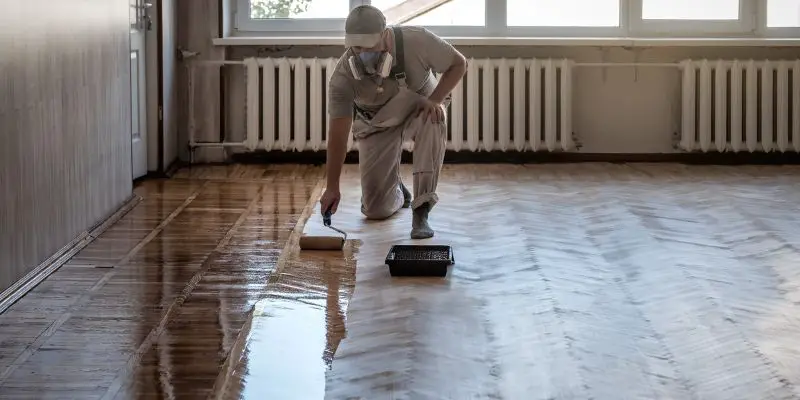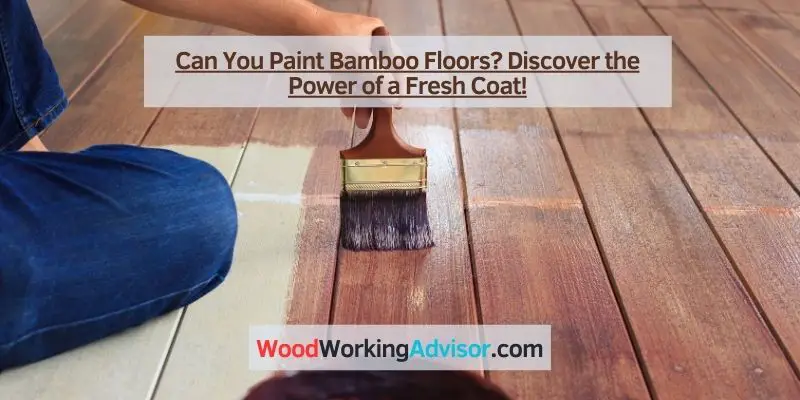Yes, you can paint bamboo floors. Painting bamboo floors allows you to change the color and style of your flooring to match your interior decor.
Bamboo floors are a popular choice due to their durability and sustainability. While staining bamboo floors is a common practice, painting them requires additional preparation and steps. We will discuss how to properly paint bamboo floors, including the necessary materials and techniques.
Whether you want to refresh the look of your existing bamboo floors or give them a completely new appearance, painting can be a cost-effective and creative solution. Read on to learn more about the process of painting bamboo floors.
Benefits Of Painting Bamboo Floors
Painting bamboo floors can be an excellent way to transform and revitalize your space. The benefits of painting bamboo floors go beyond just adding some color to your interior. In this section, we will explore the various advantages that come with painting bamboo floors.

Enhances Aesthetic Appeal
Painting bamboo floors allows you to enhance the aesthetic appeal of your space. Whether you choose a bold and vibrant color or a subtle and neutral tone, a fresh coat of paint can completely change the look and feel of your bamboo floors. It gives you the opportunity to create a unique and personalized style that perfectly matches your decor and overall design concept. With a variety of paint colors available, you can easily achieve the desired ambiance and make a powerful visual statement in your home.
Allows For Customization
One of the most significant advantages of painting bamboo floors is the ability to customize them according to your preferences. By painting your floors, you have the freedom to express your creativity and showcase your personal style. Whether you want a modern and sleek look or a vintage and rustic charm, paint allows you to achieve the desired effect. Plus, you can experiment with different patterns, designs, or even stencils to add a unique touch to your floors. This customization option opens up endless possibilities and ensures that your floors truly reflect your personality and taste.
Provides Protection
Painting bamboo floors not only enhances their appearance but also offers a layer of protection. The paint acts as a barrier that shields the bamboo from potential damage caused by moisture, scratches, or wear and tear. This protective layer helps preserve the longevity of the bamboo floors, reducing the need for frequent maintenance or refinishing. By painting your bamboo floors, you are providing them with an extra level of defense, ensuring they withstand daily use and retain their beauty for years to come.
Steps To Paint Bamboo Floors
If you’re looking to update your bamboo floors with a fresh and vibrant new look, painting them can be a great option. Not only does it give you the opportunity to personalize your space, but it also allows you to protect the bamboo from wear and tear. However, it’s important to follow the proper steps to ensure a successful paint job. In this article, we will guide you through the process of painting bamboo floors, covering everything from preparation to the finishing touches. Let’s get started!
Preparation
Before you begin painting your bamboo floors, it’s essential to prepare the surface properly. This will ensure that the paint adheres well and provides a long-lasting finish. Here are the steps to follow:
- Clean the floors thoroughly: Start by removing any dust, dirt, or grime from the surface of the bamboo floors. Use a broom or vacuum cleaner for loose debris, followed by a gentle mop with a mild cleaning solution to get rid of any stubborn stains.
- Sand the surface: Use a fine-grit sandpaper to lightly sand the bamboo floors. This will help create a rough texture, allowing the paint to adhere better. Make sure to sand evenly across the entire surface to achieve a uniform finish.
- Fill in gaps and repair damage: Inspect the floors for any gaps or damaged areas. Fill in any gaps using a wood filler and repair any cracks or scratches with wood putty. Allow the filler and putty to dry completely before moving on to the next step.
- Protect surrounding areas: Cover any furniture, walls, or other surfaces near the bamboo floors with drop cloths or plastic sheets to prevent them from getting accidentally painted.
Priming
Priming is an essential step in the painting process, especially when it comes to bamboo floors. It helps create a smooth and even surface, allowing the paint to adhere better and ensuring a more durable finish. Here’s how to prime your bamboo floors:
- Choose the right primer: Select a high-quality primer specifically designed for use on bamboo or wood surfaces. It should be compatible with the paint you plan to use.
- Apply the primer: Use a paint roller or brush to apply a thin and even coat of primer to the bamboo floors. Make sure to work in small sections and smooth out any drips or uneven spots as you go.
- Allow the primer to dry: Follow the manufacturer’s instructions for drying time. Typically, it takes a few hours for the primer to dry completely. Avoid walking on the primed floors until they are fully dry.
- Lightly sand the primed surface: Once the primer is dry, use a fine-grit sandpaper to lightly sand the surface. This will help create an even texture and remove any imperfections.
Painting
Now that your bamboo floors are prepped and primed, it’s time to paint! Follow these steps for a successful paint application:
- Select the right paint: Choose a high-quality paint that is specifically formulated for use on floors. Consider the color and finish you desire for your bamboo floors.
- Apply the paint: Use a paint roller or brush to apply an even coat of paint to the bamboo floors. Work in small sections and make sure to apply the paint in long, smooth strokes for a professional finish.
- Allow the paint to dry: Follow the manufacturer’s instructions for drying time. Depending on the type of paint, it may take a few hours or longer for the paint to dry completely. Avoid walking on the freshly painted floors until they are fully dry.
- Apply additional coats if necessary: If the color appears uneven or if you prefer a deeper hue, apply additional coats of paint following the same technique. Allow each coat to dry before applying the next.
Finishing Touches
Once the paint has dried, it’s time for the finishing touches to ensure a long-lasting and beautiful result. Here’s what you need to do:
- Apply a clear coat: After the paint has dried completely, apply a clear coat of polyurethane or a similar protective finish. This will add an extra layer of protection to your painted bamboo floors and help seal the paint.
- Allow the clear coat to dry: Follow the manufacturer’s instructions for drying time. Typically, it takes a few hours for the clear coat to dry completely. Avoid walking on the floors until the clear coat is fully dry.
- Remove the protective coverings: Once the clear coat is dry, carefully remove the drop cloths or plastic sheets used to protect surrounding areas. Dispose of any debris properly.
By following these steps, you can transform your bamboo floors with a fresh coat of paint. Remember to take your time, follow the manufacturer’s instructions for the paint and primer, and allow sufficient drying time between coats. With proper preparation and a careful application, you’ll have beautifully painted bamboo floors that will enhance the look of your space.
Frequently Asked Questions For Can You Paint Bamboo Floors
Can You Change The Colour Of Bamboo Flooring?
Yes, you can change the color of bamboo flooring. It can be stained to achieve a different shade. Make sure to prepare the surface properly and choose a compatible stain for the best results.
What Should You Not Put On A Bamboo Floor?
Avoid putting excessive moisture, harsh chemicals, heavy furniture without protective pads, high heels, and sharp objects on bamboo floors.
Can Solid Bamboo Flooring Be Refinished?
Yes, solid bamboo flooring can be refinished. Refinishing allows you to restore its beauty by sanding down the top layer and applying a new finish. This process removes scratches and wear, giving your flooring a fresh look.
Can You Stain Over Bamboo Flooring?
Yes, you can stain over bamboo flooring. Staining can enhance the color and provide a custom look. Clean the floor thoroughly and choose a suitable stain. Apply the stain in a well-ventilated area, following the manufacturer’s instructions. Allow it to dry completely before applying a protective finish.
Conclusion
Painting bamboo floors is a creative and cost-effective way to enhance the aesthetic appeal of your living space. By following the recommended steps and using high-quality paint and finishes, you can transform your floors into a stunning work of art.
Remember to prepare and clean the surface properly before painting and ensure proper drying time between coats. With proper care and maintenance, your painted bamboo floors can bring years of beauty and enjoyment to your home. So go ahead and get those brushes ready!


